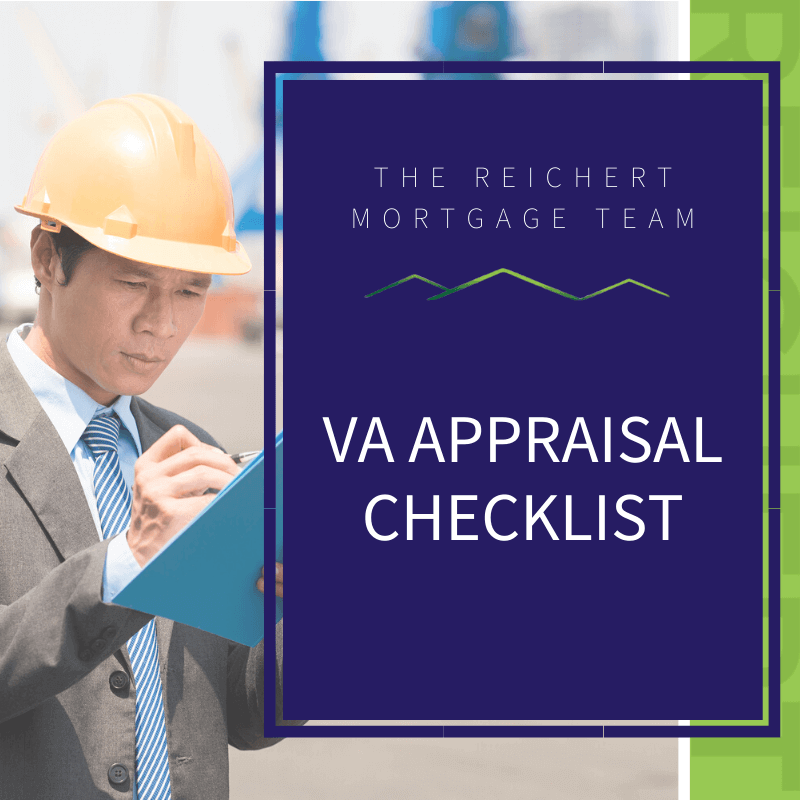You’ve qualified for your VA home loan and found the home of your dreams. You love the neighborhood, and there’s a big backyard for the dog. But there’s one more hurdle you have to cross before closing—the VA appraisal. When you use your VA benefits to purchase a home, the lender cannot offer more than the home’s fair market value. The VA also wants to make sure that your new home is safe, structurally sound, and sanitary (the three S’s).
Understanding how appraisals work alongside the VA’s Minimum Property Requirements (MPR) can save you a lot of frustration as a VA loan-qualifying homebuyer. Your VA loan specialists at The Reichert Mortgage Team created this VA appraisal checklist to help you navigate the final step of the VA loan process. After your appraisal report, you’ll be ready to move in!

What’s the Difference Between an Appraisal and a Home Inspection?
The terms appraisal and home inspection may seem similar, if not interchangeable, but actually only one of them is required to close on your VA loan.
What’s a VA Home Appraisal?
As mentioned above, the VA home appraisal has two main objectives—to ensure the asking price is fair and that the home will be safe for you and your family. Your VA appraiser will first make sure that the home meets the VA’s minimum property requirements (MPR).
Then, they will compare your home to other properties of the same size, age, and location. The home’s amenities, including the floor type, kitchen materials, square footage, can also affect property value. Then they will gather this information into an appraisal report, which helps them calculate the home’s value.
What’s a VA Home Inspection?
VA home inspections are much more in-depth than appraisals. Though your appraiser is evaluating the home’s safety, they are not identifying all potential issues with the home. An inspection report will examine your home’s architecture, plumbing, electricity, test for mold and radon, and much more. Home inspectors are not interested in the value of your home. Instead, they’ll warn you about any potential problems and suggest repairs.
Home inspections are not required for VA loans, but they are highly recommended to ensure you make a good long-term investment.
VA Minimum Property Requirement Checklist
The VA’s minimum property requirements ensure veterans and military families have a home that is safe, sound, and sanitary. MPRs also define what kind of property you can buy. For example, VA loans can only be used to purchase residential properties. If the contracted home fails to meet any of these requirements, repairs will be necessary before you can close. You can view a full list of MPRs here, but here are a few things to keep in mind. In order to close the home must have:
- Adequate heating. – The home must maintain a temperature higher than 50 degrees Fahrenheit, and homes that use a wood-burning stove must also have conventional heating.
- Secure handrails on steps and stairs.
- A permanent foundation – If the home is modular or manufactured, it must be set on a permanent foundation and have a wood or metal skirting.
- No chipping or peeling paint if the home is older than 1978. – Older homes may have lead-based paint and chipping paint increases the risk for lead poisoning.
- Water availability. – Water must be checked for safety. Disposable sewage must be safely disposed of, and wells must abide by localized laws.
- Safe plumbing. – Pipes and materials must be up to code.
- No health/safety hazards. – For example, no nuclear waste or radon poisoning, and stairs should have existing guard rails.
- Adequate roofing. – The home cannot have significant hail damage, holes, or a caving roof.
- Easily accessible entrances and exits.
- No evidence of termites.
- Dry crawl spaces.
- Space for sleeping, living, dining, and sanitation.
Generally speaking, all VA loan homes need to be move-in ready in order to pass appraisal. However, these items can still be mediated to get your VA loan approval. If the home does not meet MPRs, you can ask your seller to repair them, offer to pay for the repairs yourself, or walk away from the home.
Understanding Your VA Appraisal Report
If your home meets MPRs, you’re halfway there. The next step is to make sure that the home’s appraised value is equal to or greater than your offer. Your VA lender cannot give you a loan larger than the appraised amount per Department of Veterans Affairs guidelines. If the home’s appraised value is less than your offer, you can try to negotiate a better price with the seller.
Who Pays VA Appraisal Fees?
The appraisal fee is the buyer’s responsibility, but your VA lender will schedule the appraisal for you once your home is under contract. Appraisal fees range from $800 to $1150 with a 15-day turnaround in Colorado, although they vary across the nation, with appraisals in the midwest being the most affordable. You’ll typically pay the appraisal fee separately prior to closing.
VA Appraisal Timeline
Turnaround for VA appraisals varies from 7 to 21 business days depending on the demand in your area. As mentioned above, Colorado appraisals are usually completed within 15 days, but can be as fast as 7 in certain counties. Here’s what the VA appraisal process looks like:
1. Report Creation
Your VA appraiser will create report detailing the home’s condition and features. After the appraiser completes their report, they will upload it to the VA’s web portal for review. The appraiser does not have final say in the loan approval process.
2. Report Review
Following this upload, a VA-approved appraiser or a loan lender’s Staff Approved Reviewer (SAR) will review the report. These officials have the authority to review the appraisal, determine if the estimated market value adds up correctly, and decide if the home meets all of the MPRs.
3. Notice of Value
Your lender’s SAR should issue a Notice of Value (NOV) which informs your lender if you meet all the requirements to close the loan.
4. Clarification, Repairs, or Negotiations
The Notice of Value will indicate whether repairs need to be made or the home’s selling price should be lowered. You or your appraiser will have a chance to negotiate with the seller to close the deal.
Possible setbacks from the appraisal process mean you have to be very careful about what home you choose.
5. Approval
If all goes well, the appraisal will be finalized, and you will be on your way to finalizing your VA home loan.
Work with the VA Loan Experts
The appraisal process can be frustrating, but it is crucial to work with someone who knows the ins and outs of the VA loan process. At the Reichert Mortgage Team, we help families across southern Colorado finance their homes with great mortgage rates. We also consult clients on reducing their payments or interest rates through VA refinancing.
We are passionate about helping our Colorado community with their VA loan needs, so contact the Reichert Mortgage Team today!










